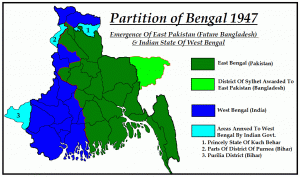Cultural Hegemony & Untold Genocides by Rinita Mazumdar PhD
Noakhali, Bengal India, now in Bangladesh: 1946:
In 1946, the Muslim majority population of India (specially in the Punjab in North West and Bengal province in the East) demanded a separate state for Muslims. One of their methods to obtain a “Muslim homeland” was genocide of the Hindu population in West Punjab and East Bengal, which both had a Muslim majority and Hindu minority populations.
From the book, Noakhali 1946 by Sandip Mukherjee, that I translated and created. Noakhali is a province in Bangladesh (present) and was also a province in undivided India (East Bengal). Here there was a massive genocide of Hindus. Some examples are given here from the testimony of one of Gandhi’s “Peace workers” or volunteers who went there to bring peace and opened refugee camps for Hindus who were evicted by the Muslims and whose houses were burned down and all their property looted:
“We were making an inventory of the killed and missing and here we were told that a total of 5 Hindus were killed, and others were missing. We made a note of all of that in our list. The attackers were well organized and their work was divided. Some had the job of setting fire to Hindu homes, some of looting, some of killing and abducting the women. Those who refused to convert were set on fire. In the entire village there was no instance of Hindus killing Muslims. In Dattapara, we heard that Mr. Rajendralala Basu did use his gun and fired some shots from the second floor and killed a couple of the Muslims. In the case of attack on Chittababu’s house one Muslim died of police firing. In Karpara what we witnessed is that they are either fleeing or fled and not attacking the attackers. For they were small compared to the hundred Muslims. There were only 15/20 Hindu households. In some villages no more than three Hindus were left. Not a single wealthy Hindu household was spared. Most of the houses were either completely burned down or partially burned down. Only some very poor huts were spared. All the young and pretty Hindu women were abducted. After this no Hindu returned to their village. After Gandhi came here and there several relief camps were open, they tried to bring the Hindus back, but none returned till this date.
A few days before the attack on Hindus, there was a rumor that something like this would happen. The people, however, were not sure. The Hindus thought that if they unify, they will be able to resist even if the attack happened. Actually, in all places they resisted. So, a batch of 500 Muslims seeing all the Hindus united fled. About 46/47 concrete houses were destroyed. In one of the villages called “Mandartalli”, the most palatial house was called “Singha[1] house” or “Lion House”. About 100 people attacked that house. A young man named Nani Singh tried to resist and protect the women of the household. The attackers came into the Courtyard and looked for the women. Nani Singha took a long sword[2] and stood in the doorway and attacked about 5 people who tried to enter. He severed the neck of one Muslim and the others fled. They were not able to take anything. At night with the help of one Muslim gentleman, the family took a boat and fled. The boat reached them to Chandpur and took some of their stuff and the rest was in the house. Next day about 4.5 thousand people came and destroyed the house.”
Noakhali 1946 by Sandip Mukherjee
Undivided
Map of Undivided Bengal. In 1947 when India won independence from British rule, two states were born, India (Hindu majority, secular democracy), and Pakistan (Muslim majority, theocratic state). West Bengal became a state in India with Hindu majority and Muslim minority, while East Bengal became East Pakistan, with Muslim majority and Hindu minority. Then in 1971, East Pakistan broke away from West Pakistan (now Pakistan) and became an independent nation, Bangladesh after India and Pakistan went for a 14 day war.
Map of undivided Bengal in 1947:

Find previous articles of Dr. Mazumdar's series on Global Conflict by clicking here.
Shiva’s Dance in Albuquerque
Rinita Mazumdar, Ph.D. is one of the leading feminist scholars in the Southwest. Originally from India, Dr. Mazumdar earned her Masters from India and Canada in Philosophy and MSc in Psychology from the University of Phoenix. She received her Ph.D. in Philosophy from the University of Massachusetts in Amherst. Find her poetry collection, “Shiva’s Dance in Albuquerque” by clicking here.

















